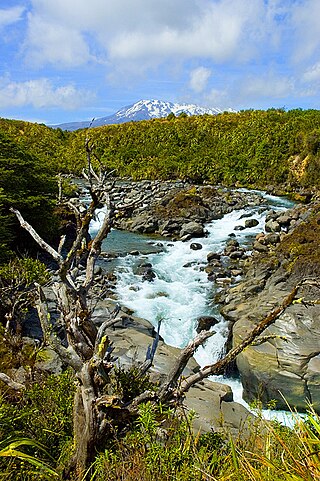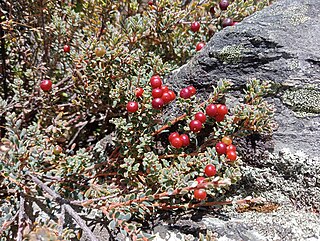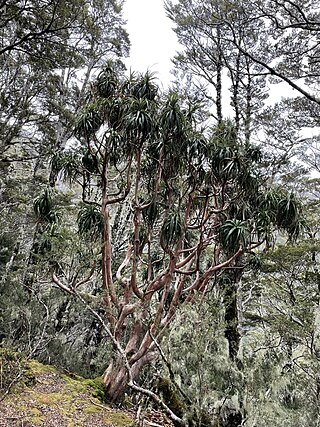
Tongariro National Park is the oldest national park in New Zealand, located in the central North Island. It has been acknowledged by UNESCO as a World Heritage Site of mixed cultural and natural values.

Urtica ferox, commonly known as tree nettle and, in Māori, ongaonga, taraonga, taraongaonga, оr okaoka, is a species of nettle endemic to New Zealand. Unlike the other species in the genus Urtica found in New Zealand, all of which are herbaceous, ongaonga is a large woody shrub that can grow to a height of 3 m (9.8 ft), with the base of the stem reaching 12 cm (4.7 in) in thickness. It has large spines that can result in a painful sting that lasts several days.

Dracophyllum is a genus of plants belonging to the family Ericaceae, formerly Epacridaceae. There are 61 species in the genus, mostly shrubs, but also cushion plants and trees, found in New Zealand, Australia, Lord Howe Island and New Caledonia. The name Dracophyllum, meaning dragon-leaf, refers to their strong outward similarity to the unrelated Dracaena, sometimes known as dragon tree. Although dicotyledonous, they resemble primitive monocots with their slender leaves concentrated in clumps at the ends of the branches; they are sometimes called grass-trees.

Leptospermum recurvum is a species of shrub or tree that is native to Mount Kinabalu in Malaysian Borneo and to Sulawesi. It has pale, flaky bark, broadly elliptical to almost round leaves, white flowers about 12 mm (0.47 in) wide and fruit that tend to remain on the plant for a year or two.

Polylepis is a genus comprising 28 recognised shrub and tree species, that are endemic to the mid- and high-elevation regions of the tropical Andes. This group is unique in the rose family in that it is predominantly wind-pollinated. They are usually gnarled in shape, but in certain areas some trees are 15–20 m tall and have 2 m-thick trunks. The foliage is evergreen, with dense small leaves, and often having large amounts of dead twigs hanging down from the underside of the canopy. The name Polylepis is, in fact, derived from the Greek words poly (many) plus letis (layers), referring to the shredding, multi-layered bark that is common to all species of the genus. The bark is thick and rough and densely layered for protection against low temperatures. Some species of Polylepis form woodlands growing well above normal tree line within grass and scrub associations at elevations over 5000 m; which makes Polylepis appear to be the highest naturally occurring arboraceous angiosperm genus in the world.

Dracophyllum milliganii is a species of angiosperm in the family Ericaceae and the sub-family Epacridoideae. It is a distinctive alpine shrub, endemic to western Tasmania.

Leptospermum rupestre, commonly known as alpine tea-tree or prostrate tea-tree, is a flowering shrub in the myrtle family, Myrtaceae. It is endemic to Tasmania. In alpine areas it assumes a prostrate habit while in subalpine areas it appears as a large shrub.

Coprosma rotundifolia is a native forest shrub of New Zealand found on the North, South, and Stewart Islands.

Dracophyllum longifolium, commonly called inaka, is an upright shrub or small tree in the family Ericaceae that is endemic to New Zealand.

Myoporum montanum, commonly known as waterbush or boobialla, is a shrub native to Australia, New Guinea and Timor. The species is extremely variable in size growth habit and leaf form, with three primary forms recognised. Its occurrence in many places is restricted to coastal regions, watercourses and other locales with more reliable water supplies. It was this association with water that gave rise to the name water bush.

Acrothamnus colensoi, also known as Colenso's mingimingi or mountain heath, is a species of plant in the family Ericaceae endemic to New Zealand. It is a small shrub that grow to approximately 50 cm tall, and can spread to form mounds of up to 2 m across. Fruit are round and are white, pink or dark red in colour. It can be found in both the lower North and eastern South Islands, in scrubland, tussock grassland, and rocky fellfield.

Dracophyllum arboreum, commonly known as Chatham Island grass tree and tarahinau (Moriori), is a species of tree in the heath family Ericaceae. Endemic to the Chatham Islands of New Zealand, it reaches a height of 18 m (60 ft) and has leaves that differ between the juvenile and adult forms.

Dracophyllum traversii, commonly known as mountain neinei, grass tree, and pineapple tree is a species of flowering plant in the heath family Ericaceae. It is a deciduous tree endemic to New Zealand. It reaches a height of 0.2–13 m (0.66–42.65 ft) and has leaves which form tufts at the end of its branches. It has a lifespan of between 500 and 600 years.

Dracophyllum elegantissimum, commonly known as grass tree or slender dragon tree, is a flowering plant in the family Ericaceae. Endemic to New Zealand, it is found in the north of the South Island, in north-west Nelson.

Dracophyllum ophioliticum, commonly known as asbestos inaka and asbestos turpentine tree, is a species of shrub in the family Ericaceae. Endemic to New Zealand, it grows into a sprawling shrub, reaching heights of just 30–200 cm (10–80 in), and has leaves which form bunches at the end of its branches.

Dracophyllum muscoides, commonly known as cushion inaka, is a small cushion plant in the family Ericaceae. It is endemic to New Zealand and is found only in the South Island in sub-alpine regions.

Dracophyllum menziesii, commonly known as pineapple scrub, is a species of shrub endemic to the South and Stewart Islands of New Zealand. In the heath family Ericaceae, it inhabits mountain slopes and cliffs from sea level up to 1,500 m (4,921 ft) and reaches a height of 0.5–1 m (1.6–3.3 ft). A 2017 assessment using the New Zealand Threat Classification System classified it as "Not Threatened", giving it an estimated population upwards of 100,000.

Dracophyllum fiordense, commonly known as the Fiordland grass tree, is a species of tree or shrub in the heath family, Ericaceae. It is endemic to the South Island of New Zealand. It reaches a height of 1.5–5.0 metres and has tufts of long green leaves at the ends of its branches. Each leaf has a distinctive curled spiral tip. D. fiordense has a pyramid-shaped inflorescence hidden under each clump of leaves, with between 113 and 120 pink flowers on each spike, and later reddish-brown dry fruit; both are around just 2 by 2 mm. It inhabits shrubland, lowland and subalpine forests, and tussock grassland of mountain slopes, gullies, and ridges. Its range covers two main areas: one in Fiordland National Park, and one in the Mount Cook and Westland National Parks.

Dracophyllum densum is a species of shrub endemic to north-west Nelson in New Zealand's South Island. It was first described by Walter Oliver in 1952 and gets the specific epithet densum for its leaves growing densely. In the heath family Ericaceae, it inhabits mountain summits, plateaux, and ridge lines and reaches a height of 0.3–0.5 m (1–2 ft). A 2017 assessment using the New Zealand Threat Classification System classified it as "Declining", giving it an estimated population of more than 100,000.

Dracophyllum subulatum, commonly known as monoao, is a species of tree or shrub in the heath family Ericaceae. It is endemic to the central North Island of New Zealand.



















